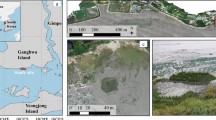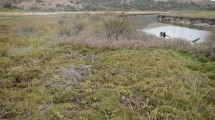Abstract
Treatment frequency is one of the key regulators determining the efficiency of and investment in controlling invasive plants. However, it is highly unlikely to find the optimal solution to the control of invasive plants through studying treatment frequency alone. In addition, the efficiency of controlling invasive plants is habitat-dependent. In this paper, clip** treatment was employed as the method to control invasive species Spartina alterniflora. We made an attempt to illustrate that clip** frequency can be reduced by considering the habitat properties and other relevant controlling regulators. Our full factorial test of combining clip** timing with considerations of clip** frequency and tidal regime showed that four-time clip** treatment started at florescence in high marsh or three-time clip** treatment started at florescence in low marsh was effective for controlling S. alterniflora. This implies that the control efficiency could be enhanced if treatment timing is optimized in relation to treatment frequency and habitat properties, which will lead to reduced management costs of controlling invasive species.



Similar content being viewed by others
References
Alber M, Swenson EM, Adamowicz SC et al (2008) Salt Marsh Dieback: an overview of recent events in the US. Estuar Coast Shelf Sci 80:1–11. doi:10.1016/j.ecss.2008.08.009
An SQ, Gu BH, Zhou CF et al (2007) Spartina invasion in China: implications for invasive species management and future research. Weed Res 47:183–191. doi:10.1111/j.1365-3180.2007.00559.x
Chen ZY (2004) Ecological impacts of the introduced Spartina alterniflora invasions in the coastal ecosystems of Chongming Dongtan, the Yangtze River estuary. The degree of doctor of philosophy, Fudan University, Shanghai, China
Daehler CC, Strong DR (1994) Variable reproductive output among clones of Spartina alterniflora (Poaceae) invading San Francisco Bay, California—the influence of herbivory, pollination, and establishment site. Am J Bot 81:307–313. doi:10.2307/2445457
Emery SM, Gross KL (2005) Effects of timing of prescribed fire on the demography of an invasive plant, spotted knapweed Centaurea maculosa. J Appl Eco 42:60–69. doi:10.1111/j.1365-2664.2004.00990.x
Gao Y, Tang L, Wang JQ (2009) Clip** at early florescence is more efficient for controlling the invasive plant Spartina alterniflora. Ecol Res. doi:10.1007/s11284-008-0577y
Genovesi P (2005) Eradications of invasive alien species in Europe: a review. Biol Invasions 7:127–133
Grevstad FS (2005) Simulating control strategies for a spatially structured weed invasion: Spartina alterniflora (Loisel) in Pacific Coast estuaries. Biol Invasions 7:665–677. doi:10.1007/s10530-004-5855-1
Hacker SD, Heimer D, Hellquist CE et al (2001) A marine plant (Spartina anglica) invades widely varying habitats: potential mechanisms of invasion and control. Biol Invasions 3:211–217. doi:10.1023/A:1014555516373
Hammond MER (2001) The experimental control of Spartina Anglica and Spartina X Townsend II in estuarine salt marsh. The degree of doctor of philosophy, University of Ulster Coleraine, Northern Ireland
Hansen MJ, Wilson SD (2006) Is management of an invasive grass Agropyron cristatum contingent on environmental variation? J Appl Ecol 43:269–280. doi:10.1111/j.1365-2664.2006.01145.x
Hempy-Mayer K, Pyke DA (2008) Defoliation effects on Bromus tectorum seed production: implications for grazing. Rangel Ecol Manag 61:116–123. doi:10.2111/07-018.1
Hobbs RJ, Humphries SE (1995) An integrated approach to the ecology and management of plant invasions. Conserv Biol 9:761–770. doi:10.1046/j.1523-1739.1995.09040761.x
Huang ZY, Sun ZH, Yu K (1993) Bird resources and habitats in Shanghai. Fudan University Press, Shanghai
Hulme PE (2006) Beyond control: wider implications for the management of biological invasions. J Appl Ecol 43:835–847. doi:10.1111/j.1365-2664.2006.01227.x
**g K, Ma ZJ, Li B et al (2007) Foraging strategies involved in habitat use of shorebirds at the intertidal area of Chongming Dongtan, China. Ecol Res 22:559–570. doi:10.1007/s11284-006-0302-7
Li B, Liao C, Zhang X, et al (2009) Spartina alterniflora invasions in the Yangtze River estuary, China: an overview of current status and ecosystem effects. Ecol Eng 35:511–520. doi:10.1016/j.ecoleng.2008.1005.1013
Li HP, Zhang LQ (2008) An experimental study on physical controls of an exotic plant Spartina alterniflora in Shanghai, China. Ecol Eng 32:11–21. doi:10.1016/j.ecoleng.2007.08.005
Ma ZJ, Li B, **g K et al (2003) Effects of tidewater on the feeding ecology of hooded crane (Grus monacha) and conservation of their wintering habitats at Chongming Dongtan, China. Ecol Res 18:321–329. doi:10.1046/j.1440-1703.2003.00557.x
Metcalfe W, Ellison A, Bertness M (1986) Survivorship and spatial development of Spartina alterniflora Loisel (Gramineae) seedlings in a New England salt marsh. Ann Bot 58:249–258
Neira C, Levin LA, Grosholz ED et al (2007) Influence of invasive Spartina growth stages on associated macrofaunal communities. Biol Invasions 9:975–993. doi:10.1007/s10530-007-9097-x
Newell SY (1996) Established and potential impacts of eukaryotic mycelial decomposers in marine/terrestrial ecotones. J Exp Mar Biol Ecol 200:187–206. doi:10.1016/S0022-0981(96)02643-3
Pan XY, Geng YP, Sosa A et al (2007) Invasive Alternanthera philoxeroides: biology, ecology and management. Acta Phytotaxon Sin 45:884–900. doi:10.1360/aps06134
Pysek P, Krinke L, Jarosik V et al (2007) Timing and extent of tissue removal affect reproduction characteristics of an invasive species Heracleum mantegazzianum. Biol Invasions 9:335–351. doi:10.1007/s10530-006-9038-0
Roundy BA, Cluff GJ, McAdoo JK et al (1985) Effects of Jackrabbit grazing, clip**, and drought on Crested Wheatgrass seedlings. J Rang Manag 38:551–555. doi:10.2307/3899751
Ruesink JL, Collado-Vides L (2006) Modeling the increase and control of Caulerpa taxifolia, an invasive marine macroalga. Biol Invasions 8:309–325. doi:10.1007/s10530-004-8060-3
Wang Q, An SQ, Ma ZJ et al (2006a) Invasive Spartina alterniflora: biology, ecology and management. Acta Phytotaxon Sin 44:559–588. doi:10.1360/aps06044
Wang Q, Wang CH, Zhao B et al (2006b) Effects of growing conditions on the growth of and interactions between salt marsh plants: implications for invasibility of habitats. Biol Invasions 8:1547–1560. doi:10.1007/s10530-005-5846-x
Wang Z, Zhang Y, Pan X et al (2006c) Effects of winter burning and cutting on aboveground growth and reproduction of Spartina alterniflora: a field experiment at Chongming Dongtan, Shanghai. Biodivers Sci 14:275–283. doi:10.1360/biodiv.060072
Weber E (2003) Invasive plant species of the world: a reference guide to environmental weeds. CABI, Wallingford
Wilson MV, Clark DL (2001) Controlling invasive Arrhenatherum elatius and promoting native prairie grasses through mowing. Appl Veg Sci 4:129–138. doi:10.1111/j.1654-109X.2001.tb00243.x
**ong SJ, Nilsson C (1999) The effects of plant litter on vegetation: a meta-analysis. J Ecol 87:984–994. doi:10.1046/j.1365-2745.1999.00414.x
Xu HF, Zhao YL (2005) Science survey on Chongming Dongtan migration birds nature reserve of Shanghai. China Forestry Publishing House, Bei**g
Acknowledgments
This work was supported by the National Basic Research Program of China (No. 2006CB403305), the National Natural Science Foundation of China (nos. 30670330 and 30870409), the Science and Technology Commission of Shanghai (No. 07DZ12038-2) and the Program for New Century Excellent Talents in University (NCET-06-0364) funded by the Ministry of Education of China.
Author information
Authors and Affiliations
Corresponding author
Rights and permissions
About this article
Cite this article
Tang, L., Gao, Y., Wang, C. et al. How tidal regime and treatment timing influence the clip** frequency for controlling invasive Spartina alterniflora: implications for reducing management costs. Biol Invasions 12, 593–601 (2010). https://doi.org/10.1007/s10530-009-9465-9
Received:
Accepted:
Published:
Issue Date:
DOI: https://doi.org/10.1007/s10530-009-9465-9




